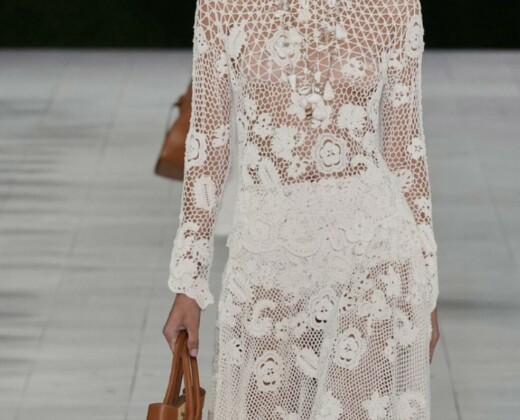Last September, AVAVAV made headlines when every model took a tumble at their SS23 womenswear show. The show was designed to be a parody of the superficial and stiff nature of the high-fashion industry. This Milan Fashion Week, Beate Karlsson shocked crowds yet again with another show that poked fun at the seriousness of luxury fashion.
First a heel snapped, then a bag strap, sunglasses came crashing to the ground and pearls rolled down the runway; before we knew it clothes were bursting off the models and the whole set collapsed. What originally seemed to be a runway disaster was quickly revealed to be a purposeful critique of the superficial and serious nature of fashion; Beate Karlsson took to Instagram to share her vision behind the ‘Fake it til you break it’ show:
“I’ve been asking myself; why is luxury so serious? The last collection was all about keeping up a fake projection of wealth and the personal failure of losing face when this illusion crashes. I’m still on that theme, there’s something very interesting with shame and what happens when we are vulnerable. What is the most embarrassing thing that can happen to a fashion house? I figured garments breaking might be it. Right now, I feel the coolest attitude is exposing your vulnerability, carrying it as an accessory.”
But you might be wondering what this all has to do with fast fashion? Well, it is this superficial projection of wealth that fuels the fast fashion industry. People become so obsessed with having every trendy item, excessive fast fashion hauls online promote an attitude of quantity over quality, all in an attempt to keep up appearances. Influencers promote an unrealistic level of consumerism, that has now become normalised. Viewers are growing up thinking that buying a new outfit for every night out and only wearing it once is completely normal and sustainable. People would rather never wear an item again than allow Instagram to see it on them twice. This has created a generational attitude that clothing does not need to last longer than one night.
The show also explored the themes of shame and vulnerability, and this is an interesting concept when it comes to clothes. Yes, if you are out in public and you have a wardrobe malfunction you feel vulnerable and exposed, but I’m not sure that you as the customer necessarily feel ashamed? Embarrassed maybe, but not shame. The notion of shame in this collection, therefore, comes from the designer and manufacturer; an admirable response to creating low-quality goods in a world that has completely normalised the lack of durability in the fashion industry.
The attitude towards fast fashion items breaking has become alarmingly normalised, the attitude of “oh well, it only cost £5” or “you get what you pay for” is seen as totally reasonable. However, you compare this attitude to this idea of clothes breaking being “the most embarrassing thing that can happen to a fashion house” and it cements the idea that clothes are meant to last. They are not supposed to rip or tear after a couple of wears, this attitude to clothing needs to be dismantled. And yes, we are aware that there is an astronomical price difference between high-street fast fashion brands and the collections that we see during Fashion Week, but you don’t need to spend that much to have clothes that last. In fact, buying higher quality items that don’t need to be replaced as often is actually better both environmentally and economically. In 2019, the House of Commons Environmental Audit Committee found that “around 300,000 tonnes of textile waste ends up in household black bins every year, sent to landfill or incinerators”, a statistic that is both scary and completely unnecessary. Similarly, The Waste and Resources Action Programme (WRAP) found that “Extending clothing life has been identified as the single largest opportunity to reduce the carbon, water and waste footprints of clothing in the UK”.
Ultimately, this show served as a reality check, reminding viewers that clothes are supposed to be well-crafted and durable items, not the things that are filling landfill sites across the globe. If we were shocked to our core at seeing items breaking on the runway, why are we not similarly shocked when it happens in our own wardrobes? Hopefully, the feeling of shame surrounding clothing waste will spread, and people will begin to make more conscientious decisions with their wardrobes causing fast fashion companies to confront their contributions to the climate crisis.
Words by: Amelia Gregory
Header Image: AVAVAV








